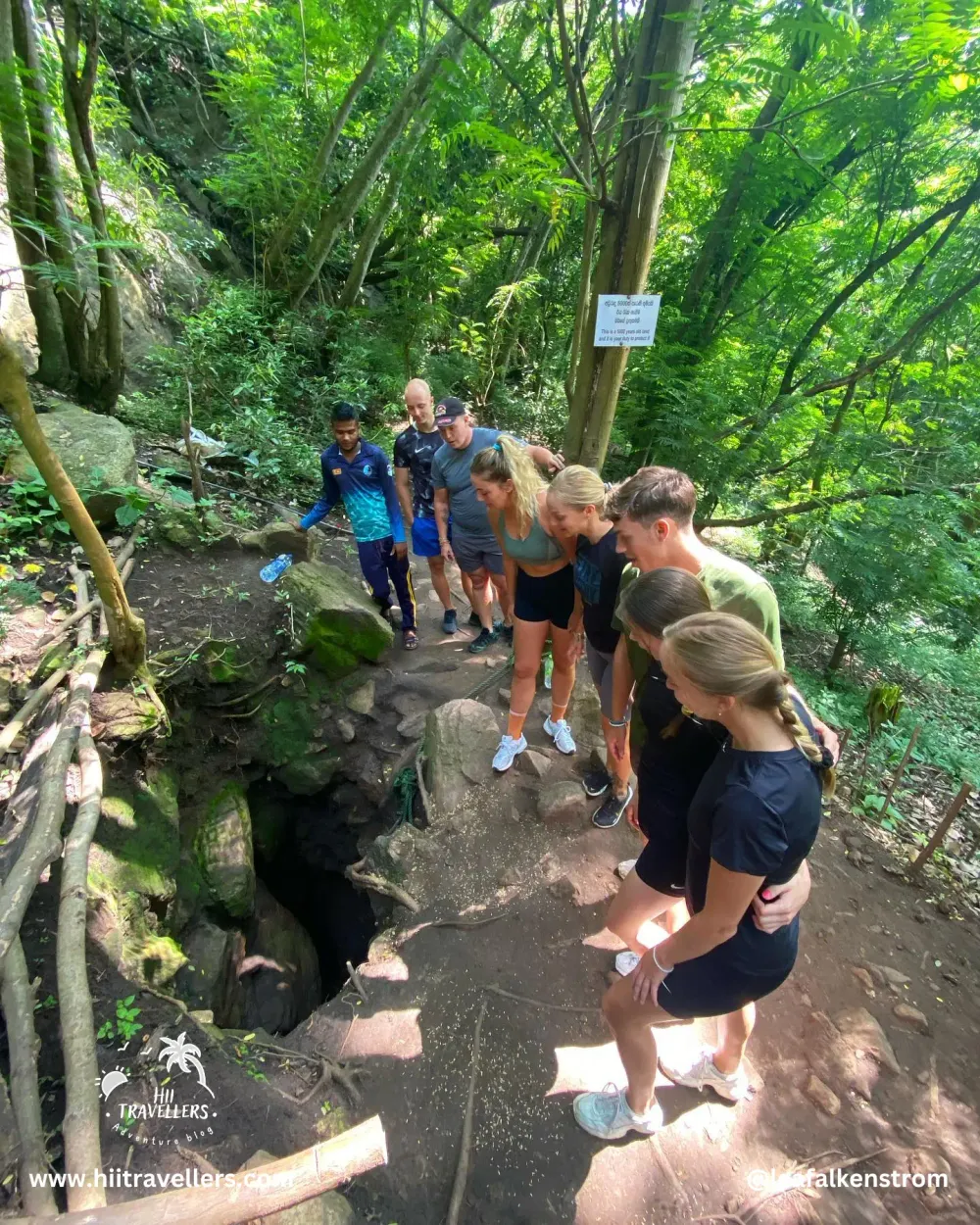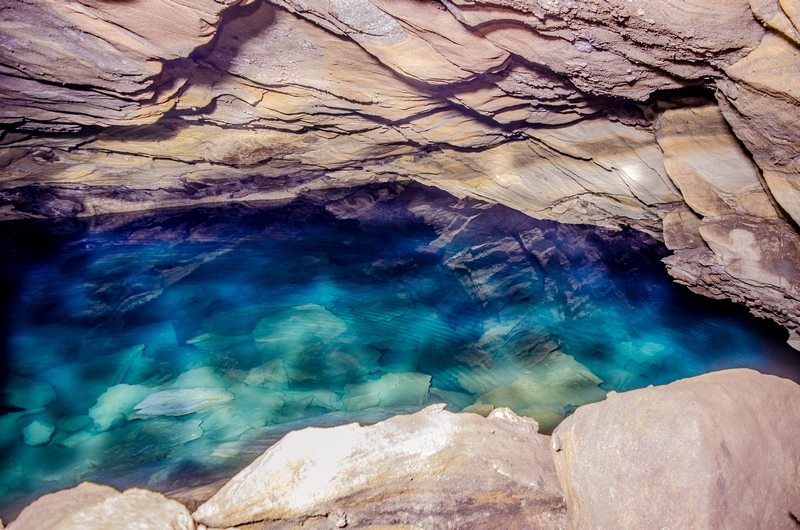Nil Diya Pokuna is an underwater pond situated in a cave or a tunnel complex in Ella which is believed to have been built by King Ravana. It is one of the most difficult places in Sri Lanka which is unreachable to reach.

What is Nil Diya Pokuna?
Nil Diya Pokuna, which translates to “Blue Water Pond,” is an underground water body located inside a deep cave system near the Ravana Ella area. This hidden attraction is believed to have historical significance dating back to the reign of King Ravana, a legendary figure in Sri Lankan folklore. The pond gets its name from the mesmerizing deep blue color of its waters, which remain untouched by sunlight.
Nil Diya Pokuna Location
The Nil Diya Pokuna, lying 80 meters deep inside a mountain cave in Karandagolla can be accessed via two independent entrances, of which the better-known one is situated in a forest reservation in the area, while a villager, then discovered about three years ago a second entrance on a private property. Although many had reached Nil Diya Pokuna via both ways.

Access to the Nil Diya Pokuna, known as the ‘Hulan-guhawa’ (wind-give-in), is not the well-known passageway utilized by travelers of the Nil Diya Pokuna. The Earlier passageway is said to have been deserted as it is excessively unsafe.
The ‘Hulan-Guhawa’ entrance is baffling, as a consistent stream of wind continues blowing out of it. This wind blowing could be experienced till just about a profundity of 3-4 meters into the give-in. From that point the wind weight gets ordinary.

The underlying drop was steep, and you needed a rope to climb down. When inching and slithering for a couple of minutes, You will achieve a passageway that you can stand and walk. However, the floor was so dangerous with Bat’s crap. At that point will enter an expansive arch-like surrender, which may have been of the extent of a soccer stadium.
Crossing through it and going further down, You will achieve the pond. The pond itself is in a surrender vault around 30 m wide. The pond is accepted to spread past the surrender walls, and its aggregate limit is difficult to predict.

Nil Diya Pokuna Story
According to the legend, sovereign “Rawana” of “Lankapura” had seized an Indian princess named ‘Seetha’ and kept her covered up for well over 10 years. A monkey man named “Hanuman” (who was a companion of Seetha’s Husband) had pondered all over Lankapura in search of a piece of information about Seetha. Subsequently, Rawana had requested Seetha be kept in an underground buckle.
Hence being under-ground for years, and not getting contact of Sunlight, Seetha is said to have lost her composition and experienced a skin disease.

At that point, Rawana is said to have constructed a system of give in ways so that Seetha could be moved from place to place, and she could invest some energy in Rawana’s Royal gardens, and bathe in adjacent waterfalls. The Ella-Karandagolla mountain range is accepted to be the place Seetha was covered up, with many give-in passages surrounding it.
One such surrender passage is found through the ‘Rawana Guhawa’ (Ravana-Cave) close to the celebrated ‘Rawna-Ella’ (Rawana-waterfall). Some trust that the baffling Nil Diya Pokuna may likewise be a pond that was utilized by Princess Seetha.
(The celebrated Indian epic “Ramayanaya” gives a very much delineated record of Rawana’s Lankapura kingdom and how Princess Seetha was kept covered up in it).
Why Visit Nil Diya Pokuna?
- Nil Diya Pokuna is more than just a tourist attraction; it’s an experience that combines adventure, history, and natural beauty. Here’s why it should be on your Sri Lanka bucket list:
- Thrilling Descent: Entering Nil Diya Pokuna involves descending into darkness, where the air becomes cooler, and the atmosphere takes on a mystical feel.
- Crystal-Clear Waters: The underground pond’s water is strikingly clear with a deep blue hue, creating an ethereal sight.
- Adventurous Exploration: The cave system is not fully explored, making it a thrilling spot for those with an adventurous spirit.
- Off-the-Beaten-Path: Unlike crowded tourist spots, Nil Diya Pokuna offers a serene and untouched environment.
- Unique Adventure: The combination of hiking and caving makes it a thrilling experience for adventure seekers.
- Cultural Significance: The site’s connection to the Ramayana adds a layer of cultural and historical intrigue.
- Photography Opportunities: The cave’s otherworldly beauty is a photographer’s dream.
Route from Colombo to Nil Diya Pokuna
By Bus: Come from Colombo to Wellawa by bus. Then, you can go along the Wellawaya-Ella-Kumbalwela highway and reach Nil Diya Pokuna.
By Train: Come from Colombo to Ella by train. Nil Diya Pokuna can be reached by bus from Ella along the Wellawaya-Ella-Kumbalwela highway.
Route from Badulla to Nil Diya Pokuna
By Bus: Start by bus from Badulla to Ella. Buses run regularly on this route. The distance between Badulla and Ella is relatively short, and the journey takes about 30 minutes on average. Once you arrive at the Ella, you can hire a tuk-tuk or walk to the Nil Diya Pokuna.
By Train: Start by train from Badulla to Ella. Trains are available from Badulla to Ella, and the journey offers beautiful views of the Sri Lankan countryside. The train journey from Badulla to Ella is short and usually takes around 30 minutes.
By Tuk-Tuk: Start by hiring a Tuk-Tuk in Badulla. You can find Tuk-Tuks at various locations around town, and it’s a good idea to negotiate the fare with the driver to ensure they can take you to Nil Diya Pokuna.
Best Time to Visit Nil Diya Pokuna
The best time to visit Nil Diya Pokuna is during the dry season, from December to March. This period has less rainfall and clearer paths, which makes the caves more accessible.
The morning is the best time of day for this adventure.
Guidelines and Safety Tips to visit Nil Diya Pokuna
Listen to Your Guide: Pay close attention to your guide’s instructions for a safe and informative journey.
Understand the Risks: Be mindful of the inherent dangers, such as sharp drops, jagged rocks, and slippery surfaces.
Be Prepared for Confined Spaces: Be prepared to trek through a dark and confined space for about 1km.
Inform Someone Before The Journey: Always let someone know that you are visiting Nil Diya Pokuna and when you expect to return.
Pack Light: Bring only essentials in a compact backpack to ease movement in tight spaces.
Stay Alert and Cautious: Always be aware of your surroundings and move with care to avoid accidents.
Photography Precautions: Use camera equipment carefully in the muddy and wet conditions of the cave.
Expect a Muddy Adventure: Be ready to get dirty, as the cave floor can be a bit muddy.
Plan for Slow Pacing: The challenging terrain means progress is slower than usual, so don’t rush.
Allocate Adequate Time: Set aside a time slot of about 3-4 hours for the entire journey to Nil Diya Pokuna.
Nil Diya Pokuna Photo Gallery
A cave like no other in Sri Lanka – Nil Diya Pokuna

Senior Lecturer from the Department of Zoology of the Faculty of Applied Sciences, University of Rajarata, Dr. Wasantha Sena Weliange who is also an authority on the ecology and functions of streams and rivers in Sri Lanka notes, that in his cave exploration experience in the country, Ravana Cave is so far the largest.
“It’s enormous compared to others. On the floor of the Ravana cave there are polygonal rock boulders ranging from about 1 meter to 4-5 metres. They are all made of common rock types like gneiss. The cave floor is not flat, but has a slope similar to the outside landscape. Another interesting factor is the Olympic-sized pool which is found inside. As there is no wind inside the cave the surface of the water is always still, which you cannot see anywhere else.”
The formation of Nil Diya Pokuna as Dr. Weliange explains is interesting. The earthly materials that surround the cave are porous. When it rains a portion of the rain flows along the surface downwards and a portion is soaked to the soil. Soaked water seeps through the soil due to gravity and this drops to the void from its roof. This accumulation of water has created the pool.
To determine the age of a cave, the age of the deposits found in a cave are analyzed, says the scholar. “For example; inside the caves there are deposits which are known as speleotherms, or galmal in lay terms which means stony sprouts. There are two major types of speleotherms known as stalagmite and stalactite. Stalagmite is commonly called Hiri Temba and stalactites are known as Hiri Lamba.
Those speleotherms started growing after the formation of the underground void, many thousands of years ago due to landslides during the last glaciation. If we determine the age of the speleotherm then it is equal to the age of the cave. There are many techniques to determine the age of those things. According to our logic, the Ravana cave could be about 25000 years old or a little less.”
– by courtesy of Sundaytimes
Conclusion
Nil Diya Pokuna is a testament to Sri Lanka’s rich natural and cultural heritage. Whether you’re drawn by the legends, the adventure, or the sheer beauty of the place, this hidden gem promises an unforgettable experience. So, pack your bags, lace up your hiking boots, and get ready to explore the mystical depths of Nil Diya Pokuna – a true wonder of Sri Lanka.
© All images and video content are credited to their respective owners.
























